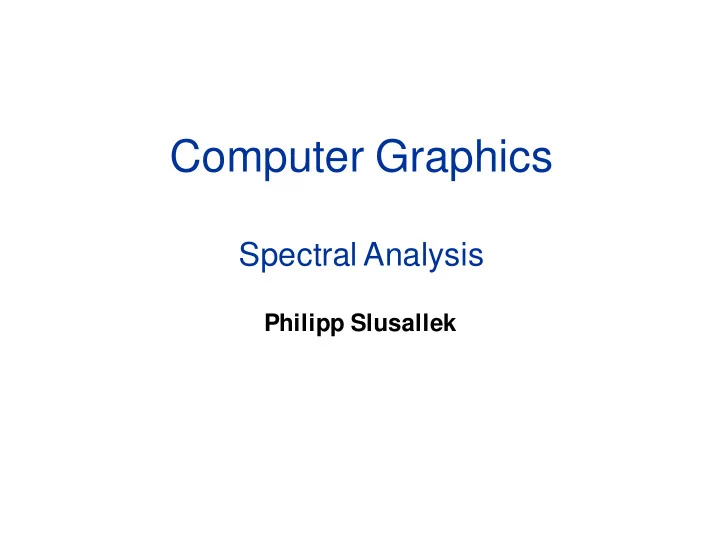

Computer Graphics Spectral Analysis Philipp Slusallek
Spatial Frequency (of an image) • Frequency – Inverse of period length of some structure in an image – Unit [1/pixel] • Lowest frequency – Image average • Highest representable frequency – Nyquist frequency (1/2 the sampling frequency) – Defined by half the image resolution • Phase allows shifting of the pattern ... 2
Fourier Transformation • Any absolute integrable function f(x) can be expressed as an integral over sine and cosine waves: Analysis: Synthesis: • Representation via complex exponential – e ix = cos(x) + i sin(x) (see Taylor expansion) • Division into even and odd parts – Even: f(x) = f(-x) (symmetry about y axis) – Odd: f(x) = -f(-x) (symmetry about origin) 𝑔 𝑦 = 1 + 1 2 𝑔 𝑦 + 𝑔 −𝑦 2 𝑔 𝑦 − 𝑔 −𝑦 = 𝐹 𝑦 + 𝑃(𝑦) • Transform of each part – Even: cosine only; odd: sine only 3
Symetric integral ([-a, a]) Analysis & Synthesis over an odd function is zero • Analysis – Even term – Odd term • Synthesis – Even term – Odd term 4
Spatial vs. Frequency Domain • Important basis functions: – Box ↔ (normalized) sinc • Negative values • Infinite support – Tent ↔ sinc 2 • T ent == Convolution of box function with itself – Gaussian ↔ Gaussian • Inverse width 5
Spatial vs. Frequency Domain • Transform behavior • Example: Fourier transform of a box function – Wide box → narrow sinc – Box → sinc – Narrow box → wide sinc 6
Fourier Transformation Periodic in space discrete in frequency (vice ver.) • – Any periodic, continuous function can be expressed as the sum of an (infinite) number of sine or cosine waves: f(x) = k a k sin(2 *k*x) + b k cos(2 *k*x) – Any finite interval can be made periodic by concatenating with itself • Decomposition of signal into different frequency bands: Spectral Analysis – Frequency band: k • k = 0 : mean value • k = 1 : function period, lowest possible frequency • k = 1.5 ? : not possible, periodic function, e.g. f(x) = f(x+1) • k max ? : band limit, no higher frequency present in signal – Fourier coefficients: a k , b k (real-valued, as before) • Even function f(x) = f(-x) : a k = 0 • Odd function f(x) = -f(-x) : b k = 0 7
Fourier Synthesis Example 8
Discrete Fourier Transform • Equally-spaced function samples ( N samples) – Function values known only at discrete points, e.g. • Idealized physical measurements • Pixel positions in an image! – Represented via sum of Delta distribution (Fourier integrals → sums) • Fourier analysis – Sum over all N measurement points – k = 0,1,2,… ? Highest possible frequency? • Nyquist frequency: highest frequency that can be represented • Defined as 1/2 the sampling frequency • Sampling rate N: determined by image resolution (pixel size) • 2 samples / period ↔ 0.5 cycles per pixel k max ≤ N / 2 9
Spatial vs. Frequency Domain • Examples (pixels vs. cycles per pixel) – Sine wave with positive offset – Square wave with offset – Scanline of an image 10
2D Fourier Transform • 2 separate 1D Fourier transformations along x and y directions • Discontinuous edge → line in orthogonal direction in Fourier domain ! 11
Convolution ∞ 𝑔 ⊗ 𝑦 = න 𝑔 τ 𝑦 − τ 𝑒τ −∞ • Two functions f , g • Shift one (reversed) function against the other by x • Multiply function values • Integrate across overlapping region • Numerical convolution: expensive operation – For each x : integrate over non-zero domain 13
Convolution • Examples 14
Convolution Theorem • Convolution in image domain → Multiplication in Fourier domain • Convolution in Fourier domain → Multiplication in image domain • Multiplication in transformed Fourier domain may be cheaper than direct convolution in image domain ! . = 15
Convolution and Filtering • Technical realization – In image domain – Pixel mask with weights • Problems (e.g. sinc ) – Large filter support • Large mask • A lot of computation – Negative weights • Negative light? 16
Filtering • Ideal low-pass filter – Multiplication with box in frequency domain – Convolution with sinc in spatial domain • Ideal high-pass filter – Multiplication with (1 - box) in frequency domain – Only high frequencies • Ideal band-pass filter – Combination of wide low-pass and narrow high-pass filter – Only intermediate frequencies 17
Low-Pass Filtering • “ Blurring ” 18
High-Pass Filtering • Enhances discontinuities in image – Useful for edge detection 19
Recommend
More recommend